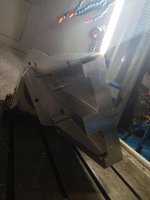MULTUSB200
Plastic
- Joined
- Feb 13, 2016
Hello friends.
Recently we've had a job running a very precise part that is approx. 12"x14"x5" cube with a few profile to datum callouts that require the fixture we work on to rotate around the 4th axis with less than 0.0004" of runout.
This means the fixture (aluminum) was milled flat and than rotated +90 - 90 and checked for parallelism with the machine's X axis.
Manipulating the tailstock proved tricky so a fixture was designed to hold the part on a fixture that mounts on the 4th axis, however when the fixture rotated +90 - 90 we saw the about 0.0004" runout aswell.
I am assuming the 4th axis is accurate and runs true (kitagawa mtx on brand new okuma mb machine)
I thought the problem could be the perpendicularity of the 4th to the table.
My question is - how common is it to put a grinding wheel in the BT tool spindle and grinding the face of the 4th perpendicular to the table and parallel to the YZ plane of the machine?
ever heard of anyone doing that?
Recently we've had a job running a very precise part that is approx. 12"x14"x5" cube with a few profile to datum callouts that require the fixture we work on to rotate around the 4th axis with less than 0.0004" of runout.
This means the fixture (aluminum) was milled flat and than rotated +90 - 90 and checked for parallelism with the machine's X axis.
Manipulating the tailstock proved tricky so a fixture was designed to hold the part on a fixture that mounts on the 4th axis, however when the fixture rotated +90 - 90 we saw the about 0.0004" runout aswell.
I am assuming the 4th axis is accurate and runs true (kitagawa mtx on brand new okuma mb machine)
I thought the problem could be the perpendicularity of the 4th to the table.
My question is - how common is it to put a grinding wheel in the BT tool spindle and grinding the face of the 4th perpendicular to the table and parallel to the YZ plane of the machine?
ever heard of anyone doing that?




